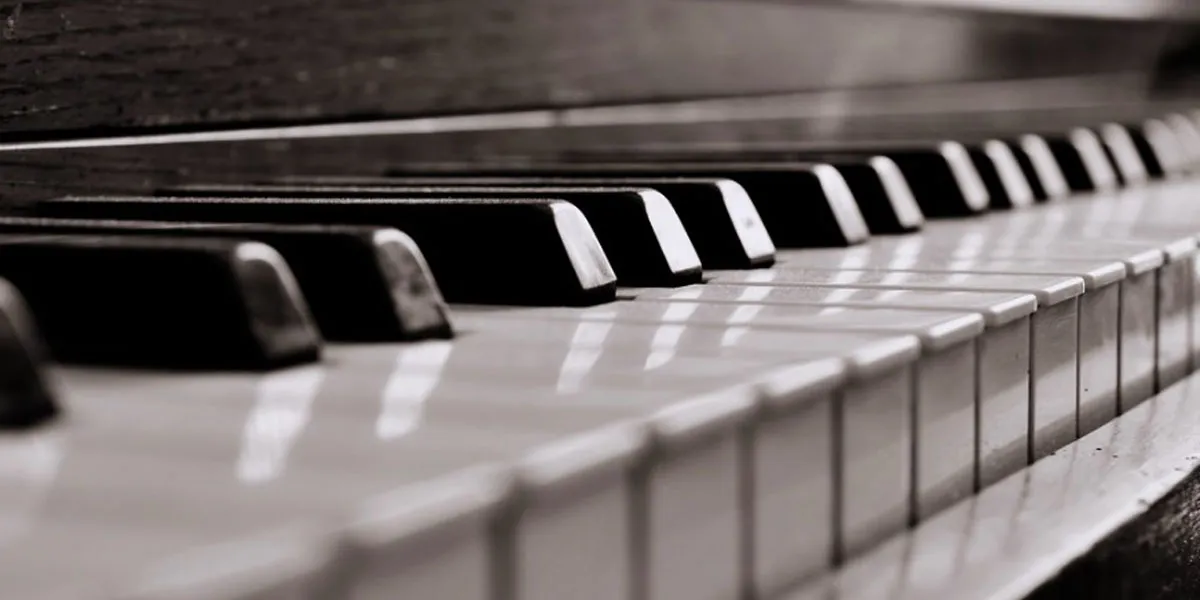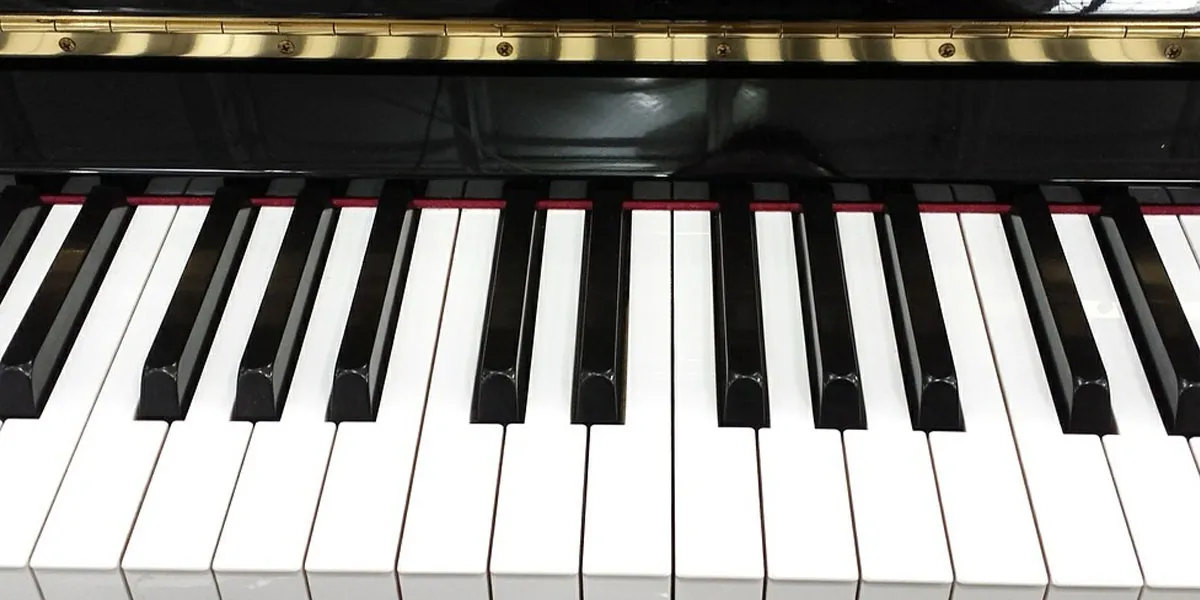The average width of a piano key is about 23.5 millimeters (0.925 inches). Standard white keys are typically 2.25 inches in length.
Understanding the size of piano keys is critical for both manufacturers and musicians. A well-crafted keyboard is central to the functionality and playability of a piano.
Each key must be precisely sized to fit the standardized dimensions of the keyboard layout, ensuring a smooth playing experience.
Pianists, especially those with different hand sizes, often consider key width when selecting an instrument, as it can affect their comfort and technique.
The standardized width ensures consistency across various pianos, making it easier for players to adapt to different instruments.
This dimension is an often overlooked yet essential aspect of piano design, contributing to the instrument’s overall touch and responsiveness.

Anatomy Of A Piano
Understanding a piano goes beyond appreciating its harmonious melodies. It involves a closer look at its physical components.
Among the most critical are the piano keys. These keys act as the interface between the pianist and the instrument’s complex internal mechanics.
A deep dive into the dimensions and materials can reveal much about the design and playability of a piano.
Key Dimensions
Each key on a piano is a marvel of precision engineering. The standard width of a piano key is about 23.5 mm for the white keys.
Black keys are narrower, typically measuring 13.7 mm wide. These dimensions ensure comfortable play for a wide range of hand sizes. Pianists can move smoothly across the keyboard, hitting notes with accuracy.
Piano enthusiasts might find it interesting to note that the length and depth of keys also contribute to touch and dynamics. Here’s a simplified breakdown:
| Key | Width | Length |
|---|---|---|
| White Keys | 23.5 mm | 150 mm |
| Black Keys | 13.7 mm | 100 mm |
Material And Texture
Historically, white keys were covered with ivory. Black keys were often ebony. Advances in materials have led to plastics and synthetic alternatives. These are more durable and ethical.
Keytops’ texture is important for grip and control. Here are common materials:
- Acrylic resin for a smooth, ivory-like feel
- ABS plastic for durability
- Satin finishes to prevent slipping
A piano’s keys tell a story not just of music, but of craftsmanship and evolution. Having a tactile connection with these keys offers a direct sensory link to the instrument’s rich heritage.
Standard Measurements
Pianos are beautiful instruments with keys just the right size for playing. Each key on a piano has a specific standard width.
This makes it easier to play for everyone. Knowing these sizes can help you understand pianos better. Let’s look at how wide these keys are.
White Keys Vs. Black Keys
White keys and black keys on the piano are different, not just in color, but also in size. The white keys are the larger keys you see.
They are the ones you play the most. Black keys, or sharps and flats, are smaller and sit higher, between the white keys.
| Key Color | Width |
|---|---|
| White Keys | ~23.5mm (Just under an inch) |
| Black Keys | ~13.7mm (A little over half an inch) |
Variations Across Models
Different piano models might have slightly different key sizes. These variations are small. Most of the time, you won’t notice them.
But they can affect how a piano feels when you play it.
- Grand pianos may have wider keys for a luxurious feel.
- Digital pianos sometimes slim the keys down a bit, to save space.
- Historic and antique pianos have keys that may not match today’s standards.
Historical Evolution

Tracing the lineage of piano keys offers a fascinating glimpse into music’s past. Key width has evolved, reflecting craftsmanship and musical preferences across centuries.
This historical evolution does not merely mark improvements. It signals the cultural and practical advancements in musical expression.
Early Keyboard Instruments
Long before the modern piano, early keyboards emerged with various dimensions. The clavichord and harpsichord reigned, influencing key size significantly.
- Clavichords, delicate and intimate, showcased narrow keys.
- Harpsichords, with their broader design, featured slightly larger keys.
These variations in size affected playability, challenging musicians to adapt dexterously.
Changes In Key Width Over Time
As musical sophistication grew, piano key width subtly changed.
| Period | Average Key Width |
|---|---|
| Baroque Era | ~1.8-2.0 cm |
| Classical Period | ~2.0-2.2 cm |
| Modern Piano | ~2.3 cm |
Over generations, pianos developed from bespoke to standardized. This shift ensured uniformity and comfort for pianists worldwide.
Today’s keys reflect this journey, offering a width that accommodates a broad range of hand sizes.
Impact On Performance
The width of a piano key might seem like a small detail. Yet, it has a huge impact on how musicians perform.
Each piano key’s width shapes how players interact with the instrument. It can comfort or challenge their hands.
This is why understanding key dimensions is crucial for both piano makers and players.
Ergonomics Of Key Size
The ergonomics of piano keys matter a lot. Pianists spend hours at their instruments. So, each key must fit their fingers perfectly.
Standard keys are about 23.5 mm or 0.92 inches wide. This size helps most players to reach each key comfortably. But, it can vary slightly from one piano maker to another.
- Better comfort leads to longer practice sessions.
- Reduces the risk of hand fatigue and injury.
- Ensures players of all hand sizes can play effectively.
Influence On Playing Technique
Key size shapes how pianists develop their playing technique. Smaller or larger keys force different finger placements.
This can affect the precision of play. Proper key width allows for optimal finger movement and technique.
| Finger Span | Key Width | Technique Impact |
|---|---|---|
| Small Hands | Narrower Keys | More agile, possible over-stretching |
| Large Hands | Wider Keys | Less nimble, better power control |
Custom And Specialized Keyboards

The universe of music embraces diversity, including in its instruments.
Custom and specialized keyboards turn the spotlight on pianists with unique needs or preferences.
These creative deviations from the standard 88-key piano often target comfort, playability, and artistic expression.
From compact designs to one-of-a-kind creations, custom keyboards speak to the individuality of the player.
Designs For Small Hands
Not all fingers stretch across standard keys with ease.
Designs for small hands offer narrower keys, allowing for comfortable reach and playability.
- Reduced key width accommodates smaller hand spans.
- Custom spacing supports precise finger placement.
- Smaller keyboards sustain portability and space efficiency.
Rare And The Unique
For some, the conventional piano keyboard doesn’t suffice.
The rare and unique category features keyboards with exceptional designs.
- Some have more than 88 keys for extended range.
- Split keyboards allow different sounds from each section.
- Keyboards with alternate tuning systems cater to experimental musicians.
These specialized instruments may even inspire new styles of music.
FAQs About the Width of a Piano Key
Are All Piano Keys The Same Width?
No, piano keys vary in width; standard white keys are wider than black keys.
What Is The Actual Size Piano Keys?
Standard piano keys are typically about 23. 5 mm (0. 925 inches) wide for white keys and 13. 7 mm (0. 54 inches) for black keys.
How Wide Is An 88 Key Piano?
An 88-key piano typically measures approximately 58 inches in width. This standard size allows for full musical range in a home or studio setting.
How Wide Is A 61 Key Piano?
A 61-key piano typically measures about 36 to 40 inches in width.
Conclusion
Unlocking the mystery of piano key dimensions has been our quest. Now you know, each key spans an average of about 23. 5 mm in width.
This knowledge enhances our understanding and appreciation of the piano’s design. Take this detail to heart as you journey through the world of music and piano mastery.
Resources:
https://people.carleton.edu/~jellinge/m208w14/pdf/02PianoNoteReference.pdf
https://www.ece.iastate.edu/~alexs/classes/2016_Spring_575/HW/HW5/files/piano-key-freq-wikipedia.pdf
